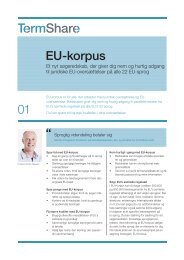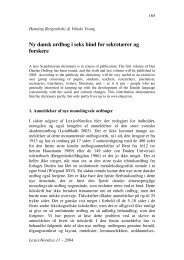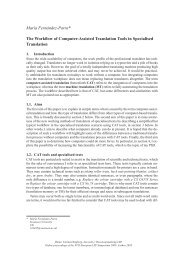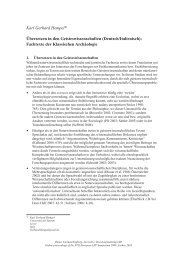Accounting for Interdiscursivity: Challenges to Professional Expertise
Accounting for Interdiscursivity: Challenges to Professional Expertise
Accounting for Interdiscursivity: Challenges to Professional Expertise
Create successful ePaper yourself
Turn your PDF publications into a flip-book with our unique Google optimized e-Paper software.
18<br />
Chris<strong>to</strong>pher N. Candlin<br />
in and of itself Layder’s elements of context and setting, and certainly<br />
not the overarching construct of his<strong>to</strong>ry. The significance of context<br />
and setting only emerges from the talk and writings of the<br />
participants, from their narratives when set against socio-his<strong>to</strong>rical<br />
accounts and studies of organizational change, shifts in national<br />
policies, analyses of decision-making over time. Including this<br />
dimension, as Layder argues one must, moves the research agenda<br />
from description and interpretation <strong>to</strong> what one can call critical<br />
explanation. Finally, in Layder’s resource map, what is the<br />
significance <strong>for</strong> the researcher of his fourth element, the self? If we<br />
see self, with Layder, as invoking identity within the context of social<br />
experience, what he refers <strong>to</strong> as the ‘unique psychobiography of the<br />
individual’ (1993: 71) located within the time-space of a life career,<br />
then the struggle between the individuality and the collectivity of the<br />
self as at once body, mind and person is revealed.<br />
Layder is, of course, writing as a social theorist and sociologist,<br />
not as someone directly connected <strong>to</strong> the analysis of professional<br />
discourse. It is not at all difficult, however, <strong>to</strong> map on<strong>to</strong> Layder’s<br />
resource map discourse analytical practices which are familiar <strong>to</strong> those<br />
concerned with professional communication. Conversational analysis<br />
focusing on charting interaction, and interactional sociolinguistics<br />
focusing on participant interpretation and inferencing can be readily<br />
married <strong>to</strong>, say, systemic-functional grammatical and prosodic<br />
analyses of textualisations, whether they be drawn from spoken,<br />
written or otherwise semiotically realized modalities. From our<br />
perspective, what Layder’s model research framework calls <strong>for</strong> is the<br />
discursive and textual analysis of identified texts, linked <strong>to</strong> an<br />
ethnographically motivated dimension which draws on qualitative<br />
evidence from participants’ narratives and accounts, in response <strong>to</strong> the<br />
siting of such texts in terms of their conditions of production and<br />
reception. Following our argument throughout in this chapter, such<br />
accounts will need <strong>to</strong> be set within an appraisal of the socio-his<strong>to</strong>rical<br />
and institutional-organizational conditions under which particular<br />
social practices arise and are privileged in various ways, and under the<br />
constraints imposed, by which particular discursive practices – <strong>for</strong><br />
example, <strong>to</strong>pic introduction and control, and speaker/writer<br />
participation rights more generally – are either promoted or<br />
proscribed. What seems important <strong>to</strong> us is that the perspectives of this











